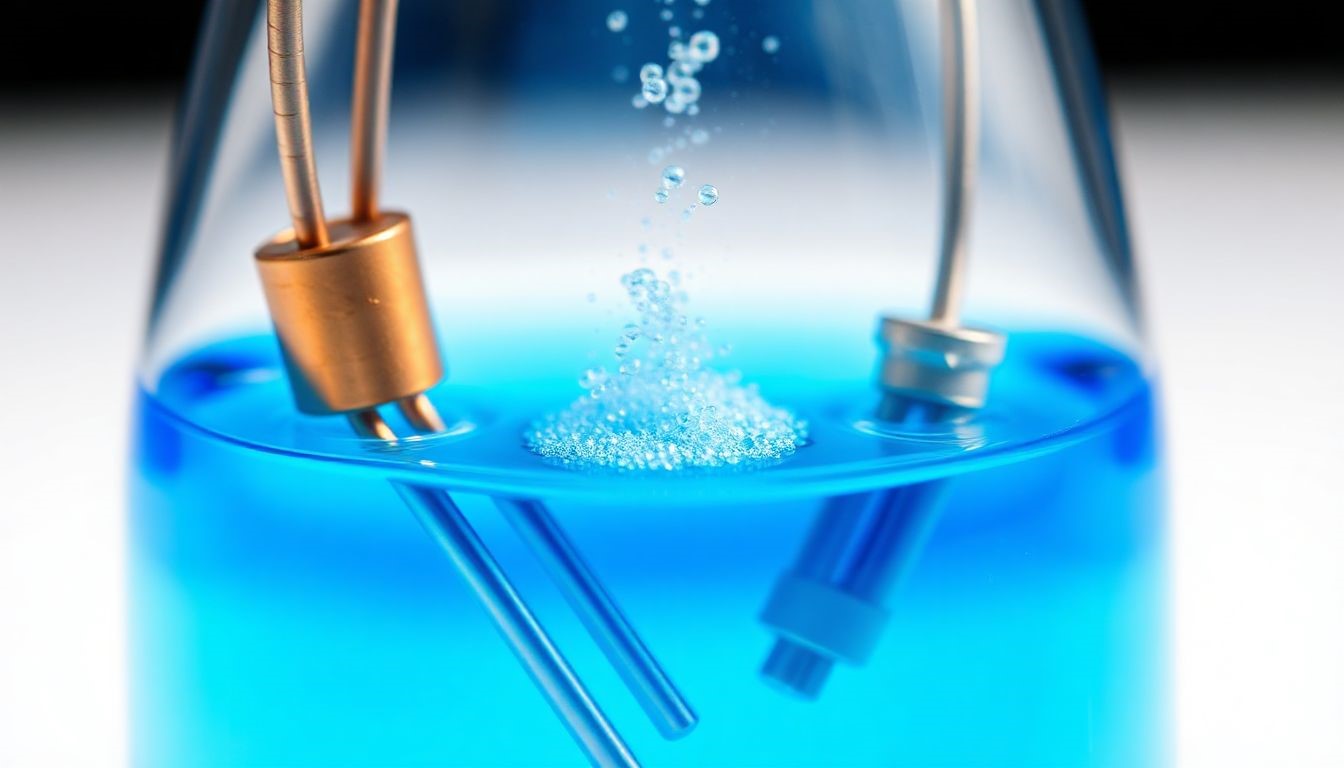What is Electrolysis?
Electrolysis is a chemical process. It uses electrical energy to drive non-spontaneous chemical reactions. This means reactions that wouldn’t happen on their own. It forces a chemical change to occur.
This differs greatly from a galvanic cell. Galvanic cells make electricity from spontaneous chemical reactions. Electrolysis goes the opposite way.
The Electrolytic Cell Components
For electrolysis to happen, you need three main parts. Each part plays a critical role.
- Electrolyte: This is the key material. It can be a molten salt or an aqueous solution. The electrolyte contains ions, which are charged atoms or molecules. These ions must be free to move for electricity to flow through the substance. Without this movement, no chemical change takes place.
- Electrodes: These are the conductors where the magic happens. The anode is the positive electrode. Here, oxidation happens, meaning electrons are lost. The cathode is the negative electrode. Reduction occurs here, meaning electrons are gained. The material of the electrodes is very important. It affects what reactions can occur and how well they work.
- Power Source: A direct current (DC) power source is essential. It acts like a pump, pushing electrons into the cathode and pulling them from the anode. This constant push is what forces the non-spontaneous reaction to proceed.
The Mechanism of Electrolysis
The Electrolytic process starts when the power source is turned on. Positive ions, called cations, move towards the negative cathode. There, they gain electrons and become neutral atoms or molecules. At the same time, negative ions, or anions, move towards the positive anode. They lose electrons there.
This transfer of electrons at the electrodes is called a redox reaction. Oxidation happens at the anode as electrons leave. Reduction occurs at the cathode as electrons enter. This continuous electron flow and ion movement lead to new chemicals forming.
4 Applications of Electrolytic Processes
Electrolysis is far more than just a lab experiment. Its uses spread across many vital industries. This powerful Electrolytic process helps create countless products we use every day.
1. Electroplating:
Electroplating coats one metal with a thin layer of another. It makes items look better or last longer. The item to be plated acts as the cathode. Metal ions in the electrolyte solution deposit onto its surface.
This technique is very common. We use chrome plating on car parts to resist rust and look shiny. Gold plating adds beauty and value to jewelry. Modern electroplating also uses new baths. These baths are safer for the environment.
2. Electro winning: Extracting Metals from Ores
Electro winning uses electricity to pull pure metals from a solution. This solution typically contains dissolved metal salts. The Electrolytic process is a type of electro-refining. It produces very pure metals.
Copper, zinc, and aluminum are often made this way. The famous Hall-Héroult process is an example. It refines aluminum from bauxite ore. This method offers high purity and efficient metal recovery.
3. Electrolysis of Water: Producing Hydrogen and Oxygen
Water electrolysis splits water molecules (H₂O) into hydrogen gas (H₂) and oxygen gas (O₂). A direct current passes through water with an electrolyte. Hydrogen forms at the cathode, and oxygen forms at the anode.
This Electrolytic process holds great promise for clean energy. Hydrogen can be a fuel source. It burns clean, producing only water. Developing “green hydrogen” using renewable energy sources is a major future goal.
4. Industrial Electrolysis in Chemical Manufacturing
Electrolysis makes many important industrial chemicals. The chlor-alkali process is a big one. It produces chlorine gas and sodium hydroxide from salt water. Both are vital for many industries.
Electrochemical synthesis also makes organic compounds. These are used in medicines and plastics. Strict safety rules are key when handling the reactive chemicals produced.
Efficiency Influencing Electrolytic Factors
Getting the most out of an electrolytic process needs careful control. Several factors greatly affect how well it works. Understanding these helps boost output and lower costs.
Current Density and Voltage
Current density is the amount of current per unit of electrode area. A higher current density generally means faster reactions. But too much can cause problems, like unwanted side reactions or poor product quality. Over potential is another factor. It’s the extra voltage needed to make the reaction go. This is more than the minimum theoretical voltage.
Electrolyte Concentration and Conductivity
The amount of ions in the electrolyte directly impacts the reaction rate. A higher concentration of active ions usually leads to faster reactions. The electrolyte’s ability to conduct electricity is also crucial. Sometimes, supporting electrolytes are added. These do not react but boost the overall conductivity.
Electrode Material and Surface Area
Picking the right electrode material is vital. Electrodes should resist corrosion from the electrolyte. They also need to promote the desired chemical reactions. Maximizing the electrode’s surface area can boost efficiency. This is because more places are available for reactions to occur.
Temperature and Pressure
Temperature affects how fast the chemical reactions happen. Higher temperatures often speed things up. They can also change the solubility of substances. For reactions that make gases, like water electrolysis, pressure matters. Higher pressure can make it harder for gases to escape. This can impact cell design.
Conclusion:
Electrolytic processes are central to many parts of our world. They help us make essential metals. They produce vital chemicals for countless products. They even offer ways to create clean energy like hydrogen.
This technology is incredibly versatile. Ongoing research continues to find new and better ways to use electricity to drive chemical change.





